Pierre Fernandez
Geometric Image Synchronization with Deep Watermarking
Sep 18, 2025Abstract:Synchronization is the task of estimating and inverting geometric transformations (e.g., crop, rotation) applied to an image. This work introduces SyncSeal, a bespoke watermarking method for robust image synchronization, which can be applied on top of existing watermarking methods to enhance their robustness against geometric transformations. It relies on an embedder network that imperceptibly alters images and an extractor network that predicts the geometric transformation to which the image was subjected. Both networks are end-to-end trained to minimize the error between the predicted and ground-truth parameters of the transformation, combined with a discriminator to maintain high perceptual quality. We experimentally validate our method on a wide variety of geometric and valuemetric transformations, demonstrating its effectiveness in accurately synchronizing images. We further show that our synchronization can effectively upgrade existing watermarking methods to withstand geometric transformations to which they were previously vulnerable.
Detecting Benchmark Contamination Through Watermarking
Feb 24, 2025Abstract:Benchmark contamination poses a significant challenge to the reliability of Large Language Models (LLMs) evaluations, as it is difficult to assert whether a model has been trained on a test set. We introduce a solution to this problem by watermarking benchmarks before their release. The embedding involves reformulating the original questions with a watermarked LLM, in a way that does not alter the benchmark utility. During evaluation, we can detect ``radioactivity'', \ie traces that the text watermarks leave in the model during training, using a theoretically grounded statistical test. We test our method by pre-training 1B models from scratch on 10B tokens with controlled benchmark contamination, and validate its effectiveness in detecting contamination on ARC-Easy, ARC-Challenge, and MMLU. Results show similar benchmark utility post-watermarking and successful contamination detection when models are contaminated enough to enhance performance, e.g. $p$-val $=10^{-3}$ for +5$\%$ on ARC-Easy.
Watermarking across Modalities for Content Tracing and Generative AI
Feb 04, 2025



Abstract:Watermarking embeds information into digital content like images, audio, or text, imperceptible to humans but robustly detectable by specific algorithms. This technology has important applications in many challenges of the industry such as content moderation, tracing AI-generated content, and monitoring the usage of AI models. The contributions of this thesis include the development of new watermarking techniques for images, audio, and text. We first introduce methods for active moderation of images on social platforms. We then develop specific techniques for AI-generated content. We specifically demonstrate methods to adapt latent generative models to embed watermarks in all generated content, identify watermarked sections in speech, and improve watermarking in large language models with tests that ensure low false positive rates. Furthermore, we explore the use of digital watermarking to detect model misuse, including the detection of watermarks in language models fine-tuned on watermarked text, and introduce training-free watermarks for the weights of large transformers. Through these contributions, the thesis provides effective solutions for the challenges posed by the increasing use of generative AI models and the need for model monitoring and content moderation. It finally examines the challenges and limitations of watermarking techniques and discuss potential future directions for research in this area.
Video Seal: Open and Efficient Video Watermarking
Dec 12, 2024



Abstract:The proliferation of AI-generated content and sophisticated video editing tools has made it both important and challenging to moderate digital platforms. Video watermarking addresses these challenges by embedding imperceptible signals into videos, allowing for identification. However, the rare open tools and methods often fall short on efficiency, robustness, and flexibility. To reduce these gaps, this paper introduces Video Seal, a comprehensive framework for neural video watermarking and a competitive open-sourced model. Our approach jointly trains an embedder and an extractor, while ensuring the watermark robustness by applying transformations in-between, e.g., video codecs. This training is multistage and includes image pre-training, hybrid post-training and extractor fine-tuning. We also introduce temporal watermark propagation, a technique to convert any image watermarking model to an efficient video watermarking model without the need to watermark every high-resolution frame. We present experimental results demonstrating the effectiveness of the approach in terms of speed, imperceptibility, and robustness. Video Seal achieves higher robustness compared to strong baselines especially under challenging distortions combining geometric transformations and video compression. Additionally, we provide new insights such as the impact of video compression during training, and how to compare methods operating on different payloads. Contributions in this work - including the codebase, models, and a public demo - are open-sourced under permissive licenses to foster further research and development in the field.
Watermark Anything with Localized Messages
Nov 11, 2024



Abstract:Image watermarking methods are not tailored to handle small watermarked areas. This restricts applications in real-world scenarios where parts of the image may come from different sources or have been edited. We introduce a deep-learning model for localized image watermarking, dubbed the Watermark Anything Model (WAM). The WAM embedder imperceptibly modifies the input image, while the extractor segments the received image into watermarked and non-watermarked areas and recovers one or several hidden messages from the areas found to be watermarked. The models are jointly trained at low resolution and without perceptual constraints, then post-trained for imperceptibility and multiple watermarks. Experiments show that WAM is competitive with state-of-the art methods in terms of imperceptibility and robustness, especially against inpainting and splicing, even on high-resolution images. Moreover, it offers new capabilities: WAM can locate watermarked areas in spliced images and extract distinct 32-bit messages with less than 1 bit error from multiple small regions - no larger than 10% of the image surface - even for small $256\times 256$ images.
Evaluation of Security of ML-based Watermarking: Copy and Removal Attacks
Sep 26, 2024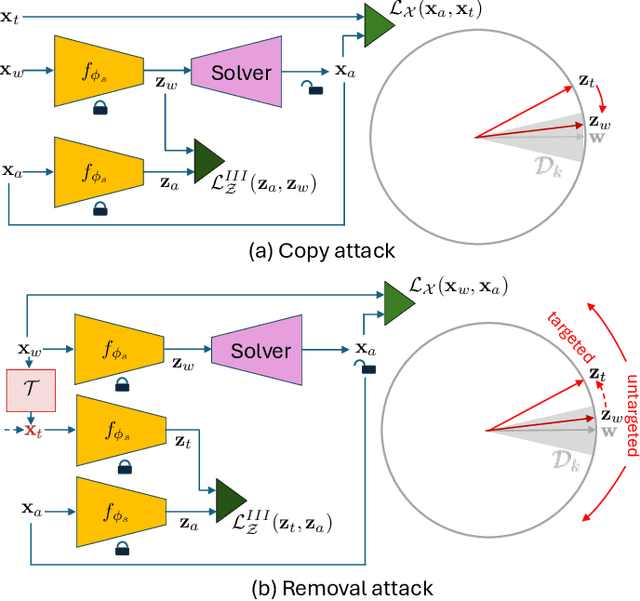
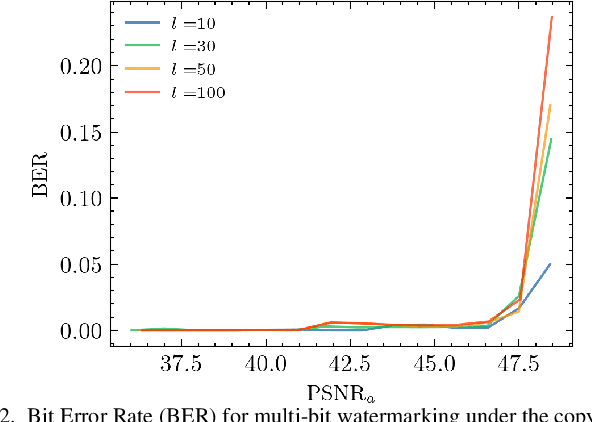
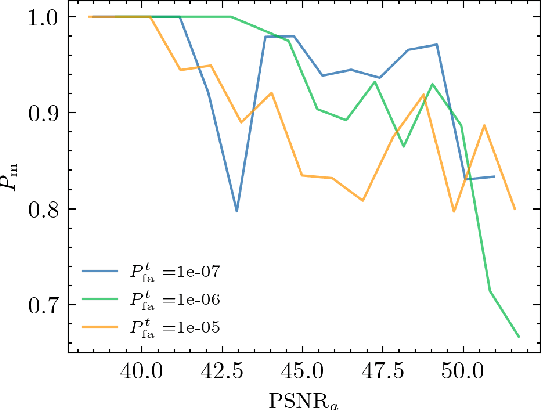
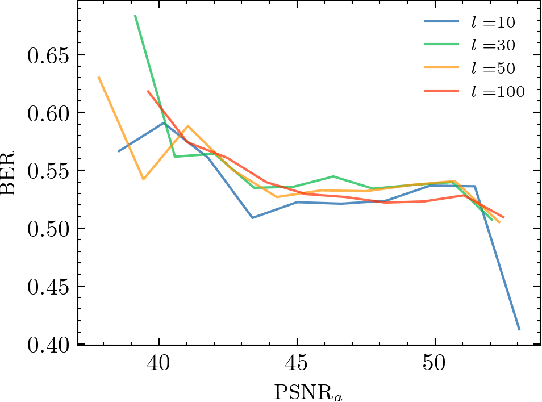
Abstract:The vast amounts of digital content captured from the real world or AI-generated media necessitate methods for copyright protection, traceability, or data provenance verification. Digital watermarking serves as a crucial approach to address these challenges. Its evolution spans three generations: handcrafted, autoencoder-based, and foundation model based methods. %Its evolution spans three generations: handcrafted methods, autoencoder-based schemes, and methods based on foundation models. While the robustness of these systems is well-documented, the security against adversarial attacks remains underexplored. This paper evaluates the security of foundation models' latent space digital watermarking systems that utilize adversarial embedding techniques. A series of experiments investigate the security dimensions under copy and removal attacks, providing empirical insights into these systems' vulnerabilities. All experimental codes and results are available at https://github.com/vkinakh/ssl-watermarking-attacks}{repository
Latent Watermarking of Audio Generative Models
Sep 04, 2024



Abstract:The advancements in audio generative models have opened up new challenges in their responsible disclosure and the detection of their misuse. In response, we introduce a method to watermark latent generative models by a specific watermarking of their training data. The resulting watermarked models produce latent representations whose decoded outputs are detected with high confidence, regardless of the decoding method used. This approach enables the detection of the generated content without the need for a post-hoc watermarking step. It provides a more secure solution for open-sourced models and facilitates the identification of derivative works that fine-tune or use these models without adhering to their license terms. Our results indicate for instance that generated outputs are detected with an accuracy of more than 75% at a false positive rate of $10^{-3}$, even after fine-tuning the latent generative model.
Watermarking Makes Language Models Radioactive
Feb 22, 2024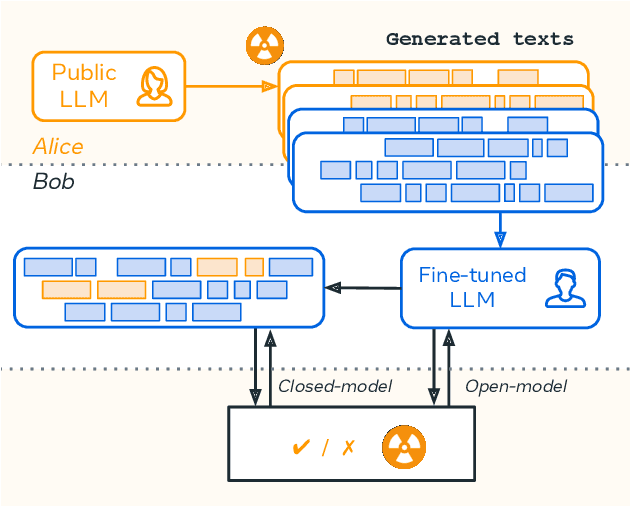

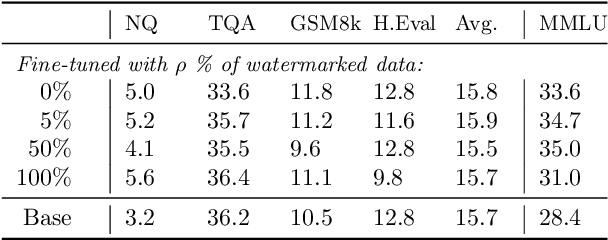
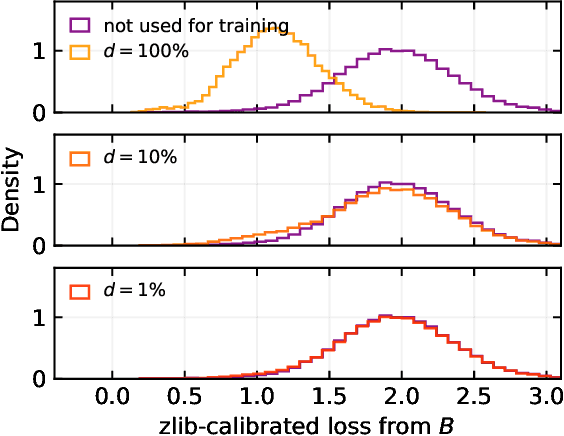
Abstract:This paper investigates the radioactivity of LLM-generated texts, i.e. whether it is possible to detect that such input was used as training data. Conventional methods like membership inference can carry out this detection with some level of accuracy. We show that watermarked training data leaves traces easier to detect and much more reliable than membership inference. We link the contamination level to the watermark robustness, its proportion in the training set, and the fine-tuning process. We notably demonstrate that training on watermarked synthetic instructions can be detected with high confidence (p-value < 1e-5) even when as little as 5% of training text is watermarked. Thus, LLM watermarking, originally designed for detecting machine-generated text, gives the ability to easily identify if the outputs of a watermarked LLM were used to fine-tune another LLM.
Proactive Detection of Voice Cloning with Localized Watermarking
Jan 30, 2024Abstract:In the rapidly evolving field of speech generative models, there is a pressing need to ensure audio authenticity against the risks of voice cloning. We present AudioSeal, the first audio watermarking technique designed specifically for localized detection of AI-generated speech. AudioSeal employs a generator/detector architecture trained jointly with a localization loss to enable localized watermark detection up to the sample level, and a novel perceptual loss inspired by auditory masking, that enables AudioSeal to achieve better imperceptibility. AudioSeal achieves state-of-the-art performance in terms of robustness to real life audio manipulations and imperceptibility based on automatic and human evaluation metrics. Additionally, AudioSeal is designed with a fast, single-pass detector, that significantly surpasses existing models in speed - achieving detection up to two orders of magnitude faster, making it ideal for large-scale and real-time applications.
Seamless: Multilingual Expressive and Streaming Speech Translation
Dec 08, 2023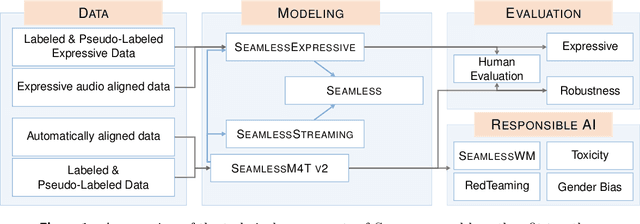
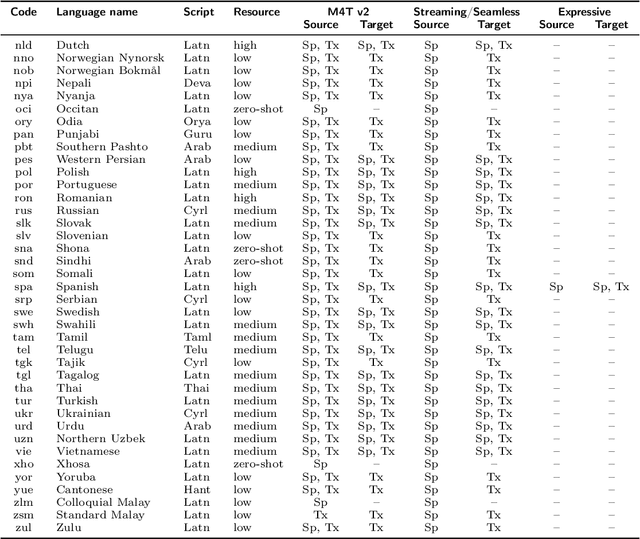

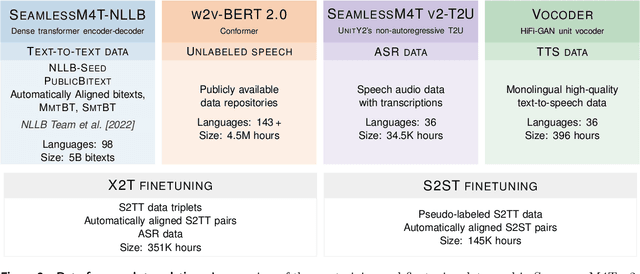
Abstract:Large-scale automatic speech translation systems today lack key features that help machine-mediated communication feel seamless when compared to human-to-human dialogue. In this work, we introduce a family of models that enable end-to-end expressive and multilingual translations in a streaming fashion. First, we contribute an improved version of the massively multilingual and multimodal SeamlessM4T model-SeamlessM4T v2. This newer model, incorporating an updated UnitY2 framework, was trained on more low-resource language data. SeamlessM4T v2 provides the foundation on which our next two models are initiated. SeamlessExpressive enables translation that preserves vocal styles and prosody. Compared to previous efforts in expressive speech research, our work addresses certain underexplored aspects of prosody, such as speech rate and pauses, while also preserving the style of one's voice. As for SeamlessStreaming, our model leverages the Efficient Monotonic Multihead Attention mechanism to generate low-latency target translations without waiting for complete source utterances. As the first of its kind, SeamlessStreaming enables simultaneous speech-to-speech/text translation for multiple source and target languages. To ensure that our models can be used safely and responsibly, we implemented the first known red-teaming effort for multimodal machine translation, a system for the detection and mitigation of added toxicity, a systematic evaluation of gender bias, and an inaudible localized watermarking mechanism designed to dampen the impact of deepfakes. Consequently, we bring major components from SeamlessExpressive and SeamlessStreaming together to form Seamless, the first publicly available system that unlocks expressive cross-lingual communication in real-time. The contributions to this work are publicly released and accessible at https://github.com/facebookresearch/seamless_communication
 Add to Chrome
Add to Chrome Add to Firefox
Add to Firefox Add to Edge
Add to Edge